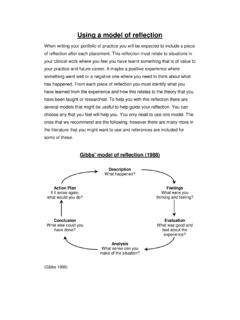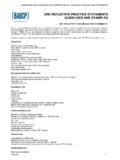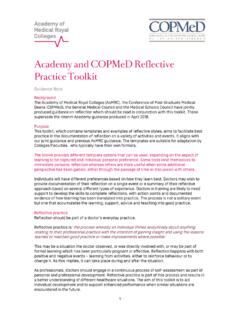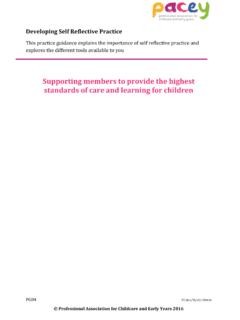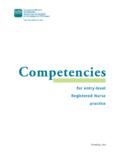Transcription of Reflective practice: a learning tool for student nurses
1 Reflective practice: a learning tool for student nursesAbstractReflection is a vital skill in contemporary nursing with student nurses expected to engage in Reflective learning from the very beginning of the nurse educational programme. This article demonstrates the meaningful learning that resulted as a consequence of using critical reflection on practice. Gibbs (1988) cycle aided the process highlighting the practical application of this cyclical framework to the author - a first-year student nurse . Matters concerning gender issues in nursing and professional conduct emerged from the analysis and were inherently explored.
2 The article concludes by demonstrating the personal benefits of using Gibbs (1988) cycle to varying situations and thus promoting its excellence as a learning tool for student nurses worldwide as a words: Gender n Intimate treatment n learning n Reflection n student nurseThe novice first-year degree nursing student encounters a steep learning curve in a relatively short amount of time. I am a first-year male student nurse who found the Reflective process a cathartic exercise which helped me cope with a practice-related issue experienced during my first clinical placement. Reflection is a vital skill in modern nursing and its use is expected from the beginning of the programme.
3 This article highlights the deep learning that resulted as a consequence of using Gibbs (1988) cycle, thus demonstrating the practical application of Reflective practice to a first-year student nurse s clinical placement. Furthermore, the article also explores how the cycle was adapted and used to provide an effective learning experience, through which the author demonstrates that reflection is of worth rebutting any claims regarding the learning potential of reflection, as some learning is better than no learning , particularly if it provides a vital step towards greater knowledge. The inclusion of the author s Reflective piece within the text serves to evidence its efficacy in informing practice and provides the context for this Mark WildingBackgroundBenner (2001) explains that nurses have not been careful record keepers of their own clinical learning .
4 Reflection provides a thorough record, and it is a well-established tool for learning . O Donovan s (2007) review of the literature clarified the success of reflection as an aid to learning in nursing. Guided reflection has been defined as: .. a journey of self-inquiry and transformation for practitioners .. to realize desirable practice as a lived reality. The journey is written as a narrative that reveals the transformative drama unfolding. Along the journey, the vision of desirable practice is constantly explored and shifting as new understandings emerge (Johns, 2006 p36). Moreover, Reflective practice and guided reflection are now a respected and required learning and assessment method in many nursing programmes worldwide.
5 The Nursing and Midwifery Council s (NMC) The Code: Standards of Conduct, Performance and Ethics for nurses and Midwives (NMC, 2008), states that nurses must keep knowledge and skills up to date throughout their working life. In particular, they should regularly engage in learning activities to develop and maintain clinical competence and performance. Reflection can aid the maintenance and achievement of clinical competence, hence an important tool in the nurse s repertoire of skills (Matthews, 2004). Reflection has been used to explore and learn from issues concerning ethics, confidentiality, communicating with patients and relatives, and other critical matters (Keen, 2000).
6 There are numerous definitions of reflection with different purposes in mind (Chirema, 2007). Whatever differences exist around the definition, there appears to be a consensus relating to the importance of reflection in nursing. Reflection has maintained a high profile on the nursing agenda (Williams and Lowes, 2001); this is further illustrated through advocacy for reflection by nursing and government professional bodies. Reflection requires self-awareness and analysis (Schutz et al, 2004), thus it is a skill that needs to be acquired, developed and maintained. The personal nature of reflection and the fact that it is sometimes used as an assessment method for learning can be a barrier to truthfully accounting the story (Schutz et al, 2004).
7 This was a major dilemma in my own Reflective writing. I therefore made a pact with myself to let go of the barriers and inhibitions, so as to permit full reflection and allow a more expansive learning experience. Williams and Lowes (2001) described a lack of definition for reflection 720 British Journal of Nursing, 2008, Vol 17, No 11 Peter Mark Wilding is Second-Year student nurse , School of Health and Social Care, University of Lincoln, Brayford PoolAccepted for publication: May 2008lymph node. The nursing care required the daily cleansing and dressing of the excised area. I was introduced to the patient, and verbal consent was obtained from the patient for me to observe the dressing procedure.
8 For the first stage of the cycle, Gibbs encourages a description of the events. The story was very simple and easy to convey. Gibbs learning cycle is appropriate for accounts such as mine, as my thoughts and feelings were important aspects of this reflection. Following the description of the story I was in a position to concentrate on the important elements. Not all narrative accounts of incidents are succinct, but I consciously endeavoured to edit the description in order to benefit from an integrated approach dealing with my thoughts and feelings directly after the explanation of the incident.
9 Otherwise I believe the complexity of writing and reading would be overwhelming and more time would be spent matching the story to the outcome and seeking clarity, rather than reflecting and was I thinking and feeling?On the way to the patient s house the staff nurse gave me a brief history of the patient. I was able to determine what a vulvectomy was for myself and the nurse simply confirmed it. It dawned on me that the cleaning would require the patient to be partly undressed. My first feeling was that of slight shock and I wondered how it would go. Many questions entered my head: Where should I look?
10 When should I look? What body language and approach would be and an ambiguous approach as barriers to effective reflection. These authors purport the true process of reflection is only initiated once the primary stage of writing has finished (Williams and Lowes, 2001), which suggests that reflection is a journey and not an ending (see Figure 1 for outline of my personal Reflective journey). By engaging with Gibbs (1988) model, I found many benefits and it suited my personal style of learning . Having the right Reflective process has bonuses for the patient, nurse , and student .

